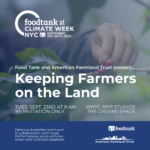A recent study from the World Resources Institute (WRI) finds young people in the United States and United Kingdom are purchasing and eating more meat than older age groups, despite saying they prioritize environmental factors when making dietary decisions.
According to the Institute, agriculture, one of the leading causes of climate change, should be a target for decreasing greenhouse gas emissions. Many young people are aware of this, and list environmentally friendly diets as a main priority, according to a report from Britainthinks. A higher percentage of younger generations are also choosing vegetarian, plant-based, or vegan diets compared to previous generations.
WRI finds that young consumers’ beliefs don’t necessarily predict dietary habits. To better understand consumers’ decisions, they reviewed evidence and analyzed two decades worth of data on food purchases of shoppers in the United Kingdom and the United States. The Institute finds that, while young people are while young people are choosing different types of meat, their overall consumption remains the same.
WRI also finds that young people are eating more meat compared to older generations. Their analyses showed that young adults ages 19-30 years eat more red and processed meat than people ages 65 and over. And youth shoppers aged 18 to 24 are purchasing the most meat compared to any other age group.
According to WRI, these findings are not necessarily surprising. “People always report themselves to be more virtuous and more ethical. And there is always a gap between intention and action,” Edwina Hughes, Engagement Leader for WRI’s Cool Food Initiative tells Food Tank.
Findings may represent a lack of awareness as well—young people may be unaware that they are eating more meat than the older generation despite their interest in the environment or sustainability. And while research is needed to understand the root causes of this trend, WRI maintains that consumer education is not enough.
“We really do need to go that extra step to make sure the choices that we want people to make are available and affordable and convenient and tasty…and also to establish social norms around plant-based eating,” Stacy Blondin, WRI Behavioral Scientist, tells Food tank.
WRI instead hopes to highlight the important role that the environment plays in consumption choices. In their free Playbook for Guiding Diner Toward Plant-Rich Dishes in Food Service WRI provides 23 interventions that members can use in the dining environment, as well as 34 other behavior changes. Examples include substituting meat for produce in a dish or using enticing language on menus to highlight the attributes and benefits of plant-rich dishes.
“It’s really important that the choice is easy for people to make so they’re not having to compromise on flavor or appearance or experience. It’s important to have an alternative that is plant-rich or plant-forward. It doesn’t necessarily have to be vegetarian and it doesn’t necessarily have to be vegan, but it is sort of about just mixing things up a bit more, maybe changing the composition, changing the proportion in some of the dishes,” Hughes tells Food Tank.
This playbook is complementary to the Cool Food Pledge, WRI’s global initiative to reduce greenhouse gas emissions associated with food service. Pledge members are food service organizations that commit to reducing their emissions by 25 percent by 2030. Members include Ikea, Panera Bread, and Harvard University. So far, WRI has seen an overall 4.6 percent decrease in food-related greenhouse gas emissions across their members, a 10 percent decrease in ruminant meat consumption, and a 12 percent increase in plant-based foods by applying these interventions.
The Institute hopes that by raising awareness of the eating habits of younger people they will be able to change their behaviors to help solve the climate crisis.
Photo courtesy of Madie Hamilton, Unsplash














